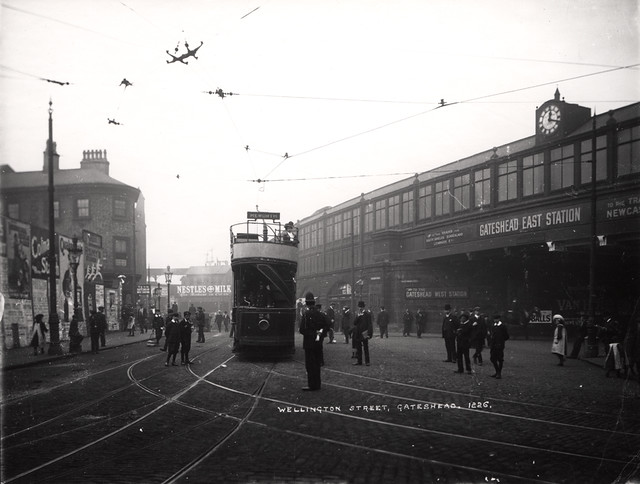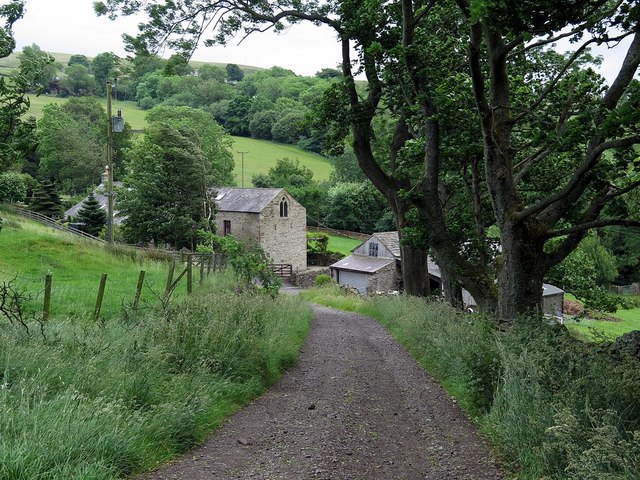Topics > Tyne and Wear > Gateshead > Gateshead Parish, 1848
Gateshead Parish, 1848
GATESHEAD (St. Mary), a borough and parish, and the head of a union, locally in Chester ward, N. division of the county of Durham, 14 miles (N. by W.) from Durham; containing, with the ecclesiastical parish of Gateshead-Fell, 19,505 inhabitants. This place is by some writers supposed to be the Roman station Gabrocentum; but the only foundation for the opinion is, the discovery of an urn containing Roman coins, and the vicinity of the ancient Watling-street, whereof a branch terminated here, from which circumstance, by the indifferent use of the terms gate and street, the name is thought to have been derived. The earliest authentic notice of the spot occurs in the account of the insurrection of the Northumbrians and the murder of Bishop Walsher while endeavouring to escape from the church, to which his assailants had set fire, in 1080, as recorded by Simeon of Durham. By whom, or at what time, the town was originally founded has not been clearly ascertained. In 1164, Bishop Pudsey granted to the inhabitants a charter of privileges nearly equal to those of Newcastle upon-Tyne, with the liberties of the forest of Gateshead, and freedom from toll within the palatinate; which grant was confirmed by his successor. In 1348, Bishop Hatfield appointed a keeper of his park in Gateshead, whom, in 1438, Bishop Neville made keeper also of Gateshead Tower, described by Leland as a "strong wardyd gate," standing on the bridge. The subsequent history of the town relates chiefly to the continued contests between the bishops of Durham and the corporation of Newcastle, respecting the right of navigating the Tyne and erecting quays on its banks, which was ultimately confirmed to the corporation.
The town is situated on the southern bank of the river Tyne, opposite to Newcastle, with which it is connected by a grand railway-bridge; and by a handsome stone bridge of nine arches, of which six belong to Newcastle and three to the see of Durham. It has five principal streets, called High-street, Oakwell-gate, Church-street, Bottle-bank, and Bridge-street, from which diverge Hill-gate to the east, and Pipewell-gate to the west, extending along the margin of the river, and various others in parallel directions. The more modern streets are West-street and High West-street, to the west of which are Brunswick-terrace, Melbourne-street, Grosvenor-street, and Mulgrave and Walker terraces; and some handsome ranges of buildings have recently been erected on the borough lands (estimated at 200 acres, and divided under an act in 1814), among which are, Sedgwick-place, Claremont-place, and Woodbineterrace, and to the west of these, Barrington-place and Ravensworth-terrace, with numerous detached and elegant mansions. An act for lighting and watching the town was passed in 1814; the supply of water is obtained partly from a reservoir on Carr-hill. The environs are pleasant; and from Windmill-hills, to the west, on which were formerly numerous mills for grinding corn, is a fine view of Newcastle, and of the vale of the Tyne. A mechanics library was established in 1836.
Of the manufactures, which are on a very extensive scale, among the principal are the Gateshead Ironworks, originally established in 1745, by Mr. William Hawks, and at present affording constant occupation to nearly 1000 men and boys, in making heavy forges, rolling-iron, heavy castings, wrought-iron wheels for railway-carriages, anchors, and chain-cables, and also scrap, bar, and all descriptions of cast and malleable iron. The Gateshead-park Iron-works were established several years since, by Messrs. John Abbott and Company, and employ about eight hundred men in the manufacture of chain-cables, anchors, and forged ironwork of every kind, tin-plates, copper bolts and sheathing, bar and sheet lead, lead-piping, and various other articles. The Durham Glass-works, near the water-side, in Pipewell-gate, belonging to Messrs. Joseph Price and Company, are conducted on a large scale for the manufacture of all kinds of glass. Mr. Price has a patent for a steam-boiler which consumes one-fourth less coal than any in general use, and was the first person that applied steam-boats to the towing of vessels, for which he was presented with a handsome piece of plate by the wharfingers and manufacturers on the Tyne, in 1818, as a testimony of the value of his services. The Tyne Soap and Alkali works give employment to 150 men in the manufacture of soap, alkali, and Glauber and Epsom salts. The Stourbridge Glass-works, and the New Stourbridge mill (chiefly for the manufacture of brown paper), are situated on the bank of the Tyne above the bridge; and from the quarries of Gateshead-Fell and the immediate neighbourhood, are raised great numbers of grindstones, well known as "Newcastle grindstones." Messrs. James Easton and Company, in 1842, opened a coal-pit at the south end of Oakwell-gate, being the only one so contiguous to the buildings of a town in the north of England. Markets were held every Tuesday and Friday, but they have been discontinued since the commencement of the 16th century. Fairs are held on the 11th of August and 28th of October, for the sale of shoes; and there are statute-fairs at Wreckington, in the south of the parish, in April and November.
Gateshead is situated on the great line of railway communication between York and Berwick-on-Tweed. The Brandling Junction railway, so called from its projector, Robert William Brandling, Esq., of Gosforth, and part of which is used by the York and Berwick trains, commences at this place, where are a spacious station and depôt, elevated on arches, and provided with every requisite arrangement: the terminus is approached from Oakwell-gate by an inclined plane for carriages, and the railway is carried over Oakwell-gate, the High-street, and West-street, by viaducts, to another station on the west side of the town. This railway connects the towns of Gateshead and Newcastle with Sunderland and South Shields; the line from Gateshead to Sunderland is 11 miles in length, from Gateshead to Shields 8 miles, and from Shields to Sunderland 7 miles. From the west of the town a branch diverges to Tanfield, about 9 miles in length, forming a junction at Redheugh, near the town, with the Blaydon branch of the Newcastle and Carlisle railway; so that goods are forwarded from the latter city direct to Sunderland and Shields, at which large quantities of coal from the collieries on the line to Tanfield moor, and the Newcastle and Carlisle railway, are shipped. The Brandling line forms also a junction at Brockley Whins with the Pontop and South Shields railway. A large portion of the land along which the Brandling railway passes, belongs to the Dean and Chapter of Durham; the whole of the line, on which are 30 viaducts and bridges, was completed at an expense of about £327,000, and was opened to the public in the month of September, 1839.
On the dissolution of the see of Durham in 1552, Gateshead was annexed to the borough of Newcastle, but on the subsequent restoration by Queen Mary, the town resumed its former independence, and the government was vested in a bailiff, appointed by the bishop. By the Municipal act of the 5th and 6th of William IV., the corporation now consists of a mayor, six aldermen, and a common-council of 18, assisted by a town-clerk, treasurer, and other officers, appointed by the council: the number of magistrates, exclusive of the mayor, is twelve, and the borough is divided into three wards, namely, the east, west, and south wards. Under the act of the 2nd of William IV., Gateshead was constituted a parliamentary borough, returning one member to parliament: the right of election is in the £10 householders, the number of whom is about 620: the mayor is the returning officer. The municipal and parliamentary boundaries are co-extensive, and include an area of 3286 acres. Petty-sessions are held every Tuesday and Friday for the borough, and every Wednesday for the county, for the northern division of which, Gateshead is a polling-place. The powers of the county debt-court of Gateshead, established in the year 1847, extend over the registration-district, or poor law union.
The living is a rectory, valued in the king's books at £27. 13. 4., and in the patronage of the Bishop of Durham. The church is an ancient and venerable cruciform structure, with a square embattled tower, which, with part of the nave, was rebuilt in 1740; though greatly altered by modern additions and repairs, it displays some fine specimens of the Norman and decorated English styles of architecture. Its interior was enlarged in 1839 with 487 sittings; and in the chancel is a beautiful window representing the Annunciation, in stained glass, presented in 1823, by Mr. Price. The chapel of ease dedicated to St. Edmund was erected in 1808, at a cost of £1331, raised by subscription; in the burial-ground is an obelisk to the memory of 222 persons who died of the cholera from December 26th, 1831, to November 5th, 1832. The hospital of St. Edmund, now called King James's Hospital, to which the chapel is attached, was founded in 1245, by Bishop Farnham, who endowed it for a master and three chaplains. It subsisted till the Reformation, but its charter having been lost, and its revenue converted to other purposes, it was refounded in 1610, by James I., for a master and three poor brethren; the mastership being appropriated to the rector of Gateshead. In 1811, the foundation was by act of parliament extended to the reception of three elder and two younger brethren, who are all appointed by the master; the income is about £455 per annum. The dilapidated chapel of the Holy Trinity, in High-street, has been restored by subscription, in the original style, and displays a beautiful specimen of early English architecture; it was opened for divine service as a chapel of ease on the 15th of October, 1837: the east window is embellished with the armorial bearings of the promoters of the restoration, in stained glass. At Bensham is a church, the first stone of which was laid in July, 1846. There are places of worship for Wesleyans, Primitive Methodists, Methodists of the New Connexion, Independents, and Presbyterians. The union of Gateshead comprises nine parishes or places, and contains a population of 38,747.
Extract from: A Topographical Dictionary of England comprising the several counties, cities, boroughs, corporate and market towns, parishes, and townships..... 7th Edition, by Samuel Lewis, London, 1848.

Co-Curate Page
Gateshead Fell Parish, 1848
- GATESHEAD-FELL, an ecclesiastical parish, in the parish and union of Gateshead, locally in Chester ward, N. division of the county of Durham. This place derives its name from Gateshead, and …











